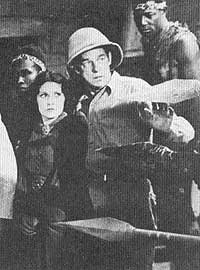 The Jungle Jim films were derived from the comic strip created by Alex Raymond in 1934. Grant Withers was the first to play Jim, in a twelve-chapter serial. The Jungle Jim films were derived from the comic strip created by Alex Raymond in 1934. Grant Withers was the first to play Jim, in a twelve-chapter serial.
Strongly influenced by H. Rider Haggard's novels of the White Goddess Ayesha in Africa, Jungle Jim (1937) features the Lion Goddess (Betty Jane Rhodes) who was a European shipwreck survivor who grew up in the bush.
The Tarzan influence is also palpable, as the Lion Goddess, like Lord Greystoke, could inherit a great deal of wealth if brought back to civilization.
Grant Withers was Loretta Young's first husband (marriage anulled) & a drinking buddy of John Wayne & John Ford. Cinematic & early television westerns kept him employed as a character actor. He was successful in this niche, but seems to have lamented his close call with actual stardom in the 1930s, this brush with greater recognition having petered out.
His career came to an abrupt end in 1959 when he committed suicide with a bottle of sleeping pills, leaving a note of apology to his Hollywood friends.
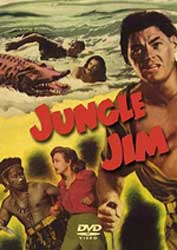 It was Johnny Weissmuller who made the character his own. Having gotten a bit thick around the waist & no longer sufficiently buff to run about half naked, it was time to make the transition from vine-swinging Tarzan to Ramar of the Jungle type who was expected to keep his clothes on. It was Johnny Weissmuller who made the character his own. Having gotten a bit thick around the waist & no longer sufficiently buff to run about half naked, it was time to make the transition from vine-swinging Tarzan to Ramar of the Jungle type who was expected to keep his clothes on.
Although his series is badly flawed by hasty cheapness at every level of production, child viewers nevertheless find these short movies convincing. For adults it's going to have to be nostalgia, sociology, or general laughableness that sustains interest.
From the series overall we will learn that nazis & other axis spies are not nice, aboriginal Africans are rarely actually black, & it's okay if white Europeans take control of all native resources for their own just so long as they're not the nazis.
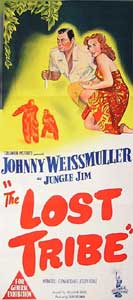 In Jungle Jim (1948), Weissmuller's first outing as Jim, he leads a beautiful research scientist (Virginia Grey) to the hidden Temple of Zimbalu in search of a cure for polio. In Jungle Jim (1948), Weissmuller's first outing as Jim, he leads a beautiful research scientist (Virginia Grey) to the hidden Temple of Zimbalu in search of a cure for polio.
Lisa Barton plays the jungle princess & Rick Vallin is her brother, the tribe's ruler. George "Superman" Reeves in a rare villain role wants to swipe a temple treasure.
Weissmuller's first Jungle Jim excursion ain't too bad for a kiddy film & is fun supplemental viewing for adults who may already be fond of him in his Tarzan films.
Second in the series, The Lost Tribe (1949), retained the same director, William Berke, who somehow failed to sustain the level of quality (if we may call it quality) from the pilot entry. Berke would direct seven of the sixteen films.
This second installment co-stars Elana Verduga as the native girl, blind Myrna Dell as the damsel in distress, & villains Ralph Dunn & Joseph Vitale.
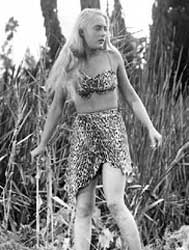 Jungle Jim tries to keep the location of the lost city of Dzamm secret, at the specific request of Zoron (Nelson Leigh), leader of the hidden people. Jungle Jim tries to keep the location of the lost city of Dzamm secret, at the specific request of Zoron (Nelson Leigh), leader of the hidden people.
When piratical sailors discover the hidden land, it's up to Jim & his army of protective gorillas to save the city. All this sounds a lot more interesting than it manages to be.
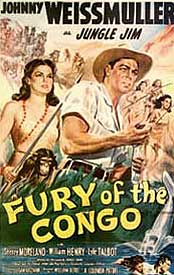 Mark of the Gorilla (1950) has gold-thieving nazis dressed up in gorilla suits scaring people. Mark of the Gorilla (1950) has gold-thieving nazis dressed up in gorilla suits scaring people.
This was followed by Captive Girl (1950) with a Sheena type feral jungle girl (Anita Lhoest) called the Wild Girl of Lake Bokonji. Her beauty in the leopard costume makes this one of the more striking episodes, even though production values aren't overall an improvement.
Pygmy Island (1950) regards a search for a plant the fibres of which produce flame resistant cloth, with assistance from a pygmy tribe that includes little-people actors Billy Curtis & Billy Barty.
Sherry Moreland co-stars in the role of an "Amazon" leader in Fury of the Congo (1951). Jungle Jim encounters a cult of natives who worship an unknown species of animal called Okongo, which looks like a fake zebra. There's also a giant spider the poison from which is a potent narcotic. This is one of the best in the series.
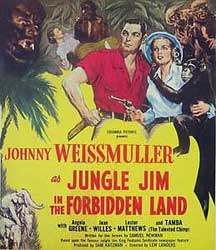 Jungle Manhunt (1951) should appeal to Charlie Manson. Charlie wanted to start a race war which he figured black people would win because they're more savage, but when most of the white people were dead, the blacks would need a white leader to get by, so Charlie'd get to be king. Jungle Manhunt (1951) should appeal to Charlie Manson. Charlie wanted to start a race war which he figured black people would win because they're more savage, but when most of the white people were dead, the blacks would need a white leader to get by, so Charlie'd get to be king.
This may seem a particularly insane type of racism that only a psycho like Manson would've believed, but kids were exposed to this idea pretty regularly in films like Jungle Manhunt which just naturally presume that if some white guy becomes lost in the African jungle, next time anyone sees him he'll be king of some aboriginal tribe.
This episode includes also a recycled dinosaur fight, a recipe for making diamonds, & stock footage up the wazoo.
In Jungle Jim in the Forbidden Land (1952), Jim & his cute chimp Tamba, together with a beautiful anthropologist (Angela Green) & some bad guys, visit a hidden land of giant beasts & giant people. The prehistoric giant couple are played by Clem "Tex" Erickson & Irmgard Helen H. Raschke.
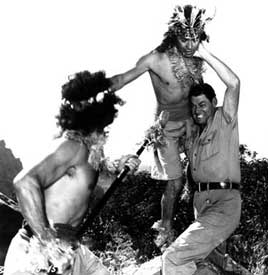 Voodoo Tiger (1952) has a postwar Nazi villain with a stash of art treasures. A headhunter tribe worships a tiger which is a pal of Jungle Jim's. Voodoo Tiger (1952) has a postwar Nazi villain with a stash of art treasures. A headhunter tribe worships a tiger which is a pal of Jungle Jim's.
Savage Mutiny (1953) has Jim helping to relocate aboriginal peoples so that the US government can use their land for atomic bomb testing, a plot based on what really happened to the people of the Bikini Islands, which was an abominable injustice, though you'd never guess it from Jungle Jim's attitude.
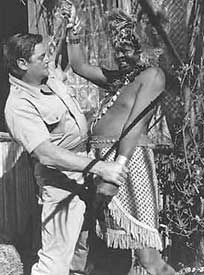 Elements of the Great White Burden inform many episodes including Valley of the Headhunters (1953) in which warring tribes require the peace mediation of Jungle Jim or they'd never have united against a common foe. Elements of the Great White Burden inform many episodes including Valley of the Headhunters (1953) in which warring tribes require the peace mediation of Jungle Jim or they'd never have united against a common foe.
Plus the villain of the piece is the guy who'd keep Jim from wresting away mineral rights from aboriginal lands. Funny what was considered good vs evil in those days!
Killer Ape (1953) regards a dangerous man-ape (Max Palmer), possibly the Missing Link, & a group of dastardly scientists who want to test biological weapons on the jungle's animal life, which gets Jungle Jim as well as the man-ape up in arms.
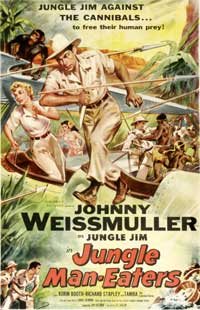 Jungle Man-Eaters (1954) has nothing in it that eats men, so the title must be metaphoric, about a villainous diamond smuggler Leroux who wants to a kindly tribe run off their traditional lands so that he can make a deal with Chief Zulu, whose tribe (apparently Zulus) are portrayed as rather a snarky & more willing to bargain with a villainous whitey seeking control of a hidden diamond mine. Obviously nobody knew much about Zulus! Possibly the lowest point in the whole series. Jungle Man-Eaters (1954) has nothing in it that eats men, so the title must be metaphoric, about a villainous diamond smuggler Leroux who wants to a kindly tribe run off their traditional lands so that he can make a deal with Chief Zulu, whose tribe (apparently Zulus) are portrayed as rather a snarky & more willing to bargain with a villainous whitey seeking control of a hidden diamond mine. Obviously nobody knew much about Zulus! Possibly the lowest point in the whole series.
Cannibal Attack (1954) although one of the "Jungle Jim" series now has the central character called "Jungle Johnny" after the series star Johnny Wiessmuller. The name-change came about because rights to the character had lapsed & been resold for a television series, yet Weissmuller had to fulfill his Columbia contract for three more of the films.
In this first "Jungle Johnny" episode, our hero is pitted against spies who steal a shipment of cobalt while improbably disguised as crocodiles. Jungle Johnny was not as much a friend to wildlife as was Tarzan, & proves himself not adverse to killing some big game.
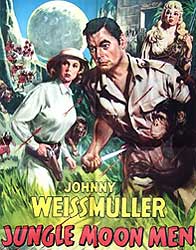 Jungle Moon Men (1955) again has Jungle Johnny rather than Jim. The episode was inspired more than most by H. Rider Haggard's novels. The immortal Queen Oma (Helena Stanton) is patterned after Haggard's She-Who-Must-Be-Obeyed of the novels She, Ayesha & Wisdom's Daughter. Jungle Moon Men (1955) again has Jungle Johnny rather than Jim. The episode was inspired more than most by H. Rider Haggard's novels. The immortal Queen Oma (Helena Stanton) is patterned after Haggard's She-Who-Must-Be-Obeyed of the novels She, Ayesha & Wisdom's Daughter.
Queen Oma rules over the last vestiges of an ancient Egyptian cult, & the queen herself is worshipped by a race of pygmies, whose king is played by Billy Curtis. The queen is worshipped in her dark, lion-infested Temple of Baku, but her immortality finally comes to a close when she is exposed to sunlike, which turns her into cornmeal.
The sixteenth & last of the Jungle Jim/Jungle Johnny films was Devil Goddess (1955). It's a slapdash effort just to finish off Weissmuller's contract. Johnny leads Professor Blake (Selmer Jackson) & his daughter Nora (Angela Stevens) into an unexplored jungle seeking a missing scientist (William M. Griffith).
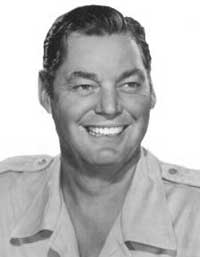 There just happens to be a lost Arabian treasure in the vicinity. They encounter the Kirundi people who are fire-eaters & make virgin sacrifices to a fire-demon in a nearby volcano. Vera M. Francis plays the native girl who must be saved from the flames. There just happens to be a lost Arabian treasure in the vicinity. They encounter the Kirundi people who are fire-eaters & make virgin sacrifices to a fire-demon in a nearby volcano. Vera M. Francis plays the native girl who must be saved from the flames.
The Screen Gems television series that had taken over the copyrighted character was Jungle Jim which ran for 26 episodes in one season (1955-1956). The series retained Johnny Weissmuller as its star.
Terribly inferior to the films (which were already cheap enough), the tv episodes do at least preserve the features's tendency toward the fantastic.
"Land of Terror" (episode #2) places Jim, his son Skipper, & Tamba the chimp inside a volcano in a lost world of dinosaurs. "Treasure of the Inca" (#3) involves an Inca city in South America. "Power of Darkness" (#26) takes place partly in Koati, a Lost City of sun-worshippers accessible only through a cavern.
copyright © by Paghat the Ratgirl
|
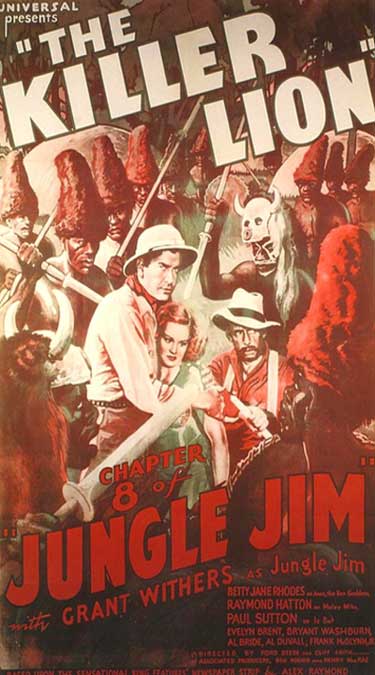



 Jungle Jim tries to keep the location of the lost city of Dzamm secret, at the specific request of Zoron (Nelson Leigh), leader of the hidden people.
Jungle Jim tries to keep the location of the lost city of Dzamm secret, at the specific request of Zoron (Nelson Leigh), leader of the hidden people.


 Elements of the Great White Burden inform many episodes including Valley of the Headhunters (1953) in which warring tribes require the peace mediation of Jungle Jim or they'd never have united against a common foe.
Elements of the Great White Burden inform many episodes including Valley of the Headhunters (1953) in which warring tribes require the peace mediation of Jungle Jim or they'd never have united against a common foe.

 There just happens to be a lost Arabian treasure in the vicinity. They encounter the Kirundi people who are fire-eaters & make virgin sacrifices to a fire-demon in a nearby volcano. Vera M. Francis plays the native girl who must be saved from the flames.
There just happens to be a lost Arabian treasure in the vicinity. They encounter the Kirundi people who are fire-eaters & make virgin sacrifices to a fire-demon in a nearby volcano. Vera M. Francis plays the native girl who must be saved from the flames.